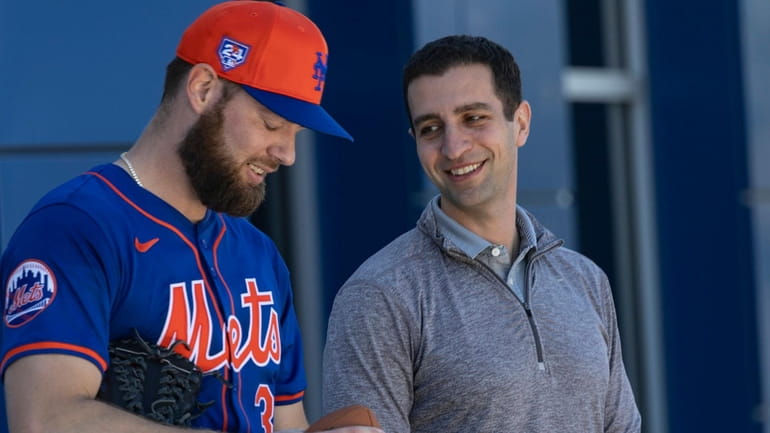Meet the new Mets, the David Stearns Mets

Mets president of baseball operations David Stearns (right) and pitcher Adrian Houser during a spring training workout, Wednesday Feb. 14, 2024 in Port St. Lucie, Fla. Credit: Newsday/Alejandra Villa Loarca
PORT ST. LUCIE, Fla. — This season marks the start of another new era for the Mets, one they hope lasts much — much — longer than the most recent ones. They desperately want stability and success after remarkably little of either for going on a decade.
The men in the middle of it all are their marquee offseason acquisitions: David Stearns, the front-office boss as president of baseball operations, and Carlos Mendoza, the manager. After years of splashy winter moves creating humongous payrolls, owner Steve Cohen passed on such transactions this time around, instead trying to set up his franchise’s future by hiring new decision-makers.
Mendoza is a newbie, having served as Aaron Boone’s bench coach for the Yankees the past four seasons. Stearns, though, is a veteran, having guided the Brewers through a rebuild and to the playoffs four times in seven seasons.
In 2024 and beyond, the Mets will be molded to the vision of those men. Their challenge in Year 1: balancing trying to win with evaluating young players.
“The truth is, if I’m doing my job right, there may not be hallmarks [of a typical Stearns-built team],” said Stearns, a Manhattan native who grew up rooting for the Mets. “We’re going to adjust to the available players. We’re going to adjust to what our team needs at any given point. We’re going to be hopefully aware of what our team needs in a particular time, in a particular season, be able to address those needs and be able to integrate young, talented players from the minor leagues into the major leagues.”
There will, of course, be major differences between the Stearns Brewers and the Stearns Mets. The most obvious is payroll. Milwaukee usually ranked in the middle of the pack; the Mets, even in their bridge year this season, are looking at an estimated majors-leading $340 million, according to public projections, following the late addition of designated hitter J.D. Martinez. But there are lessons to be gleaned from Brewers rosters — and players — of seasons past.
“His background is with the Astros, and they’re really good on defense,” said Mets catcher Omar Narvaez, who played for Milwaukee from 2020-22. “For the three years that I was on the Brewers, everything was about defense and taking good, quality at-bats to combine with the defense. That’s how we did most of our winning.”
Defense matters, especially up the middle. The Mets appear improved in that area for 2024, especially with the signing of centerfielder Harrison Bader.
Recent iterations of the Brewers also featured strong bullpens bolstered by hidden gems, players tossed aside by other clubs. And they had a homegrown — and inexpensive — rotation core, among the rarest of roster-construction luxuries, in most cases only a daydream for team officials.
The Mets hope their pitching future looks similar, particularly with the opening of their high-tech pitching lab last summer. For now, they are working with a patchwork starting five featuring a trio of offseason additions: Luis Severino, Sean Manaea and Adrian Houser.
Houser joined the Mets alongside outfielder Tyrone Taylor via a trade with, yes, the Brewers.

“I wasn’t expecting it at all,” said Houser, a member of the Milwaukee organization before, during and after the Stearns years. “I know how [Stearns] operates and what he’s trying to do. It hits a little closer to home for him, being from New York and the Mets kind of being his team growing up. So I think with that, he’s going to have a little bit of an extra edge on it, try to really make this team thrive and be a good team again for years to come.”
In separate interviews, Houser, Taylor and Narvaez shared the same low-key key to the Brewers’ success: They liked each other.
In baseball today, when so much of what the Mets and other clubs do is driven by data, intangibles such as meshing as a clubhouse still matter, they said.
“[Stearns] brings a good brotherhood to the clubhouse,” Narvaez said. “That’s important because in September, everybody is tired of seeing each other. That’s when it matters. You still want to be around each other.”
Houser added: “He does a really good job of finding guys who may be under the radar or someone may not put them in the top tier, but they come in the clubhouse and jell well together.”
And Taylor: “He preaches connection. He wants us all to connect on and off the field. That’s the vibe I get from him.”
Outfielder Ben Gamel, a Brewer in 2019-20 who was in Mets spring training on a minor-league deal, felt similarly.
“The more you like the guy to your right and left — the better relationship you have with those guys — the more you’re going to want to do for them out on the field,” he said.
To Stearns, finding players who are talented and get along is important, but that second piece “often, frankly, starts with the major-league manager,” he said.
That’s where Mendoza comes in. Considered a managerial prospect for years before the Mets hired him, he earned early rave reviews as a hybrid manager who has a sturdy feel for the game — both the people who play it and the analytics that shape it.
“I do emphasize that [team chemistry]. But it’s far from me doing that," Stearns said. "It relies so much on other people buying into that and believing it. We can control providing the right atmosphere, providing a welcoming atmosphere, encouraging guys to build those connections. That’s something that Mendy talks about all the time. Get to know your teammates, build those connections, build those relationships.
“What you actually remember from these seasons and these games are the relationships and the people you’re around. Yes, we all remember the big wins and those are exciting. But what lasts are the relationships. If we keep that on the front of our minds and we act like that, it generally yields an environment where people want to show up to work.”
BEAT WRITER’S PREDICTION
Record: Third in NL East, 83-79
On paper in March, the Mets look mediocre. But here is the thing about the modern baseball landscape, featuring an over-expanded playoff field: The bar is so low that being on the high end of
mediocrity will get you into the late-season postseason picture, which is the stated goal of new bosses David Stearns and Carlos Mendoza. Playoffs or not, this is a bridge year for the Mets, who want to evaluate their younger major-league players while grooming the next waves. Team success would be a bonus.
Tim Healey has covered the Mets for Newsday since 2018.

